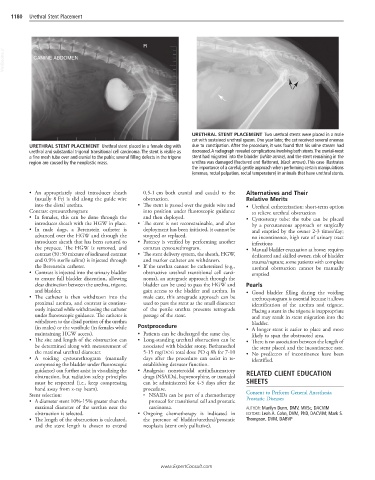Page 2387 - Cote clinical veterinary advisor dogs and cats 4th
P. 2387
1180 Urethral Stent Placement
R
VetBooks.ir CANINE ABDOMEN
URETHRAL STENT PLACEMENT Two urethral stents were placed in a male
cat with sustained urethral spasm. One year later, the cat received several enemas
URETHRAL STENT PLACEMENT Urethral stent placed in a female dog with due to constipation. After the procedure, it was found that his urine stream had
urethral and substantial trigonal transitional cell carcinoma. The stent is visible as decreased. A radiograph revealed complications involving both stents. The cranial-most
a fine mesh tube over and cranial to the pubis; several filling defects in the trigone stent had migrated into the bladder (white arrow), and the stent remaining in the
region are caused by the neoplastic mass. urethra was damaged (fractured and flattened, black arrows). This case illustrates
the importance of a careful, gentle approach when performing certain manipulations
(enemas, rectal palpation, rectal temperature) in animals that have urethral stents.
• An appropriately sized introducer sheath 0.5-1 cm both cranial and caudal to the Alternatives and Their
(usually 8 Fr) is slid along the guide wire obstruction. Relative Merits
into the distal urethra. • The stent is passed over the guide wire and • Urethral catheterization: short-term option
Contrast cystourethrogram: into position under fluoroscopic guidance to relieve urethral obstruction
• In females, this can be done through the and then deployed. • Cystostomy tube: the tube can be placed
introducer sheath with the HGW in place. • The stent is not reconstrainable, and after by a percutaneous approach or surgically
• In male dogs, a Berenstein catheter is deployment has been initiated, it cannot be and emptied by the owner 2-3 times/day;
advanced over the HGW and through the stopped or replaced. no incontinence, high rate of urinary tract
introducer sheath that has been sutured to • Patency is verified by performing another infections
the prepuce. The HGW is removed, and contrast cystourethrogram. • Manual bladder evacuation at home: requires
contrast (50 : 50 mixture of iodinated contrast • The stent delivery system, the sheath, HGW, dedicated and skilled owner, risk of bladder
and 0.9% sterile saline) is injected through and marker catheter are withdrawn. trauma/rupture; some patients with complete
the Berenstein catheter. • If the urethra cannot be catheterized (e.g., urethral obstruction cannot be manually
• Contrast is injected into the urinary bladder obstructive urethral transitional cell carci- emptied
to ensure full bladder distention, allowing noma), an antegrade approach through the
clear distinction between the urethra, trigone, bladder can be used to pass the HGW and Pearls
and bladder. gain access to the bladder and urethra. In • Good bladder filling during the voiding
• The catheter is then withdrawn into the male cats, this antegrade approach can be urethrocystogram is essential because it allows
proximal urethra, and contrast is continu- used to pass the stent as the small diameter identification of the urethra and trigone.
ously injected while withdrawing the catheter of the penile urethra prevents retrograde Placing a stent in the trigone is inappropriate
under fluoroscopic guidance. The catheter is passage of the stent. and may result in stent migration into the
withdrawn to the distal portion of the urethra bladder.
(in males) or the vestibule (in females while Postprocedure • A longer stent is easier to place and more
maintaining HGW access). • Patients can be discharged the same day. likely to span the obstructed area.
• The site and length of the obstruction can • Long-standing urethral obstruction can be • There is no association between the length of
be determined along with measurement of associated with bladder atony. Bethanechol the stent placed and the incontinence rate.
the maximal urethral diameter. 5-15 mg/DOG total dose PO q 8h for 7-10 • No predictors of incontinence have been
• A voiding cystourethrogram (manually days after the procedure can assist in re- identified.
compressing the bladder under fluoroscopic establishing detrusor function.
guidance) can further assist in visualizing the • Analgesia: nonsteroidal antiinflammatory RELATED CLIENT EDUCATION
obstruction, but radiation safety principles drugs (NSAIDs), buprenorphine, or tramadol
must be respected (i.e., keep compressing can be administered for 4-5 days after the SHEETS
hand away from x-ray beam). procedure.
Stent selection: ○ NSAIDs can be part of a chemotherapy Consent to Perform General Anesthesia
• A diameter stent 10%-15% greater than the protocol for transitional cell and prostatic Prostatic Diseases
maximal diameter of the urethra near the carcinoma. AUTHOR: Marilyn Dunn, DMV, MVSc, DACVIM
obstruction is selected. • Ongoing chemotherapy is indicated in EDITORS: Leah A. Cohn, DVM, PhD, DACVIM; Mark S.
• The length of the obstruction is calculated, the presence of bladder/urethral/prostatic Thompson, DVM, DABVP
and the stent length is chosen to extend neoplasia (stent only palliative).
www.ExpertConsult.com

